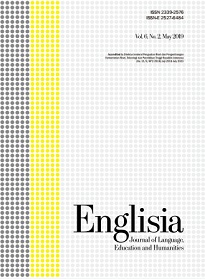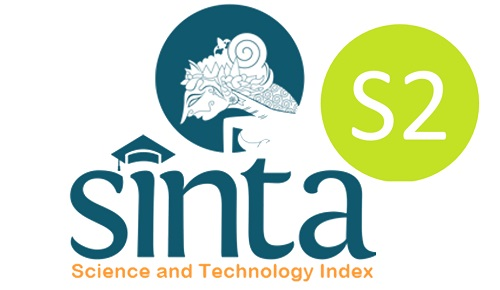Prophets and people of the Semitic religion in English translated Quran: Corpus and CDA over western power dominance
DOI:
https://doi.org/10.22373/ej.v9i2.10672Keywords:
English-translated Quran, Corpus linguistics, Critical discourse analysis, Prophets and PeopleAbstract
The Quran is the oldest scripture revealed by Allah to the Prophet Muhammad (peace be upon Him), and its originality has been preserved to this day, as evidenced by the language it employs—Arabic. It has become a popular reference for Muslims and non-Muslims alike, especially since the 9/11 tragedy. Not surprisingly, its native text, Arabic, is now widely available in translated versions, with English-translated Quran being the most frequent. The current study intends to investigate the meta-religious text concerning Prophets and the people mentioned in the Quran. The primary data of this study were obtained from the English-translated Quran by Talal Itani and analyzed with qualitative analysis software, NVivo 12 Plus, using the text search and query feature. Following that, discourse analysis was used to examine the text, social cognition, and sociocultural context. The results indicate that Moses ranked first in the Prophets category with 135 references, while the other prophets had a varied distribution: Abraham had 72, Jesus had 25, and Muhammad had 12 references. People of Israel were the most frequently discovered words with 42 mentions, followed by Jew, Christian, and Muslim. This research reveals surprising discursive evidence showing Muhammad and Muslims were the lowest of all categories. This means that the Quran is a revelation that is aimed not only for Muslims but also for all humanities, particularly the other Semitic religions: Christianity and Judaism.
Downloads
References
Ali, A., Brakhw, M. A., Nordin, M. Z. F. Bin, & ShaikIsmail, S. F. (2013). Some linguistic difficulties in translating the holy Quran from arabic into English. International Journal of Social Science and Humanity, 2(6), 588–590. https://doi.org/10.7763/ijssh.2012.v2.178
Al-Rawi, A. (2017). Burning the Quran. In Islam on YouTube (pp. 59-70). Palgrave Macmillan, London.
Al-Saggaf, M. A., Yasin, M. S. M., & Ho-Abdullah, I. (2013). Cognitive meanings in selected English translated. International Journal on Quranic Research (IJQR), 3(4), 1–18.
Al-Tarawneh, A. (2021). The role of Quran translations in radicalizing Muslims in the west and misrepresenting Islam. Journal of Religion and Violence, 9(1), 101-122.
Aqad, M. H. A., Bin Sapar, A. A., Bin Hussin, M., Mohd Mokhtar, R. A., & Mohad, A. H. (2019). The English translation of Arabic puns in the holy Quran. Journal of Intercultural Communication Research, 48(3), 243–256. https://doi.org/10.1080/17475759.2019.1609568
Hamoud, B., & Atwell, E. (2016). Quran question and answer corpus for data mining with WEKA. Proceedings of 2016 Conference of Basic Sciences and Engineering Studies, SGCAC 2016, 211–216. https://doi.org/10.1109/SGCAC.2016.7458032
Hussain, J., Shahzad, S. K., Sadaf, N., Farman, H., & Sarwat, S. (2020). Rhetorical Analysis of Surah An Naba of the English Translated Version by Muhammad Marmaduke Pickthall. International Journal of English Linguistics, 10(5), 240. https://doi.org/10.5539/ijel.v10n5p240
Ismail, R., Rahman, N. A., & Bakar, Z. A. (2017). Ontology learning framework for Quran. Advanced Science Letters, 23(5), 4175–4178. https://doi.org/10.1166/asl.2017.8237
Khosravi, S. (2012). White masks/Muslim names: Immigrants and name-changing in Sweden. Race and Class, 53(3), 65–80. https://doi.org/10.1177/0306396811425986
Mehrandasht, A., Familrouhany, S. A. A., Ghods, A., & Movahhedisirat, S. (2015). Surveying information ethics in Quran: A quantitative content analysis. Health, Spirituality and Medical Ethics, 2(1), 18-25.
Mohamad, M., Zadeh, H., Lashkarian, A., & Zadeh, M. S. (2018). Translating the Holy Quran : A Comparative Analysis of Al-Fatiha Verse from Arabic to English. 6(01), 57–64.
Mohammadpour, Soheila, & Nikoopour, Jahanbakhsh. (2017). Topicalization in English Translation of the Holy Quran: A Comparative Study. Journal of Language and Translation, 16(7), 21–33.
Nelson-Pallmeyer, J. (2005). Is religion killing us? Violence in the Bible and the Quran. A&C Black.
Mohammadi Pouya, F., & Salehi, A. (2015). Content Analysis of Holy Quran According to the Concept of Critical Thinking1. Islamic Perspective on Educational Science, 2(3), 25-49.
Ngula, R. (2018). Corpus methods in language studies. Perspectives on Conducting and Reporting Research in the Humanities, (August), 205–223. Retrieved from https://www.researchgate.net/publication/327234896
Pouya, M.F., & Salehi, A. (2015). Content Analysis of Holy Quran According to the Concept of Critical Thinking1. Islamic Perspective on Educational Science, 2(3), 25-49.
Sharaf, A. B. M., & Atwell, E. S. (2012). QurAna: Corpus of the Quran annotated with Pronominal Anaphora. Proceedings of the 8th International Conference on Language Resources and Evaluation, LREC 2012, 130–137.
Tabrizi, A. A., & Mahmud, R. (2012). Transformation of Research in Islamic Studies. Discourse Processing Issues on English-Translated Quran (First Edit; A. F. A. Hamid, W. A. W. Ramli, & S. H. Abdullah, eds.). Kuala Lumpur Malaysia.
Takim, L. (2004). From conversion to conversation: Interfaith dialogue in post 9-11 America. The Muslim World, 94(3), 343.
Van Dijk, T. A. (1996). Discourse. Cognition and Society', Discourse & Society, 7(1), 5-6.
Venkatraman, A. (2007). Religious basis for Islamic terrorism: The Quran and its interpretations. Studies in Conflict & Terrorism, 30(3), 229-248.
Yunus, M. A., Zainuddin, R., & Abdullah, N. (2010). Semantic query with stemmer for quran documents results. ICOS 2010 - 2010 IEEE Conference on Open Systems, (Icos), 40–44. https://doi.org/10.1109/ICOS.2010.5720061
Zeroual, I., & Lakhouaja, A. (2016). A new Quranic Corpus rich in morphosyntactical information. International Journal of Speech Technology, 19(2), 339–346. https://doi.org/10.1007/s10772-016-9335-7
Downloads
Published
Issue
Section
License
Proposed Policy for Journals That Offer Open Access
Authors who publish with Englisia journal agree to the following terms:
- Authors retain copyright and grant the journal right of first publication with the work simultaneously licensed under a Creative Commons Attribution License that allows others to share the work with an acknowledgement of the work's authorship and initial publication in this journal.
- Authors are able to enter into separate, additional contractual arrangements for the non-exclusive distribution of the journal's published version of the work (e.g., post it to an institutional repository or publish it in a book), with an acknowledgement of its initial publication in this journal.
- Authors are permitted and encouraged to post their work online (e.g., in institutional repositories or on their website) prior to and during the submission process, as it can lead to productive exchanges, as well as earlier and greater citation of published work (See The Effect of Open Access).









